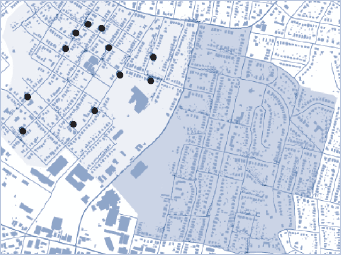
Center for Problem-Oriented Policing
Step 21: Collect your own data
In the course of your routine analytic work, you probably use mainly crime incident and arrest data, but for problem-oriented projects, you will need to use a much wider array of data. For example, calls-for-service data could give you a better handle on the amount of drug dealing at troublesome locations than arrest data. And data kept by the city and by businesses could be helpful in analyzing problems of vandalism or shoplifting, both of which are poorly measured by police reports. But for most problem-oriented projects you will find it necessary to go into the field - to use research terminology - and gather data yourself. For example, you and your project team might have to make systematic observations of the environmental features of crime sites; you might have to survey victims; and you might have to interview offenders or persuade officers to do this for you. The need for your own data collection can arise at any one of the four stages of SARA as the following examples show:
- Ronald Clarke was involved in a project focused on vehicle-related thefts in downtown parking lots in Charlotte, North Carolina. It turned out that the city did not have up-to-date maps showing the location of every parking lot because new lots were continually being opened on the sites of demolished buildings and new buildings were being erected on the sites of former lots. Consequently, police officers working on the project had to survey the entire downtown area to make a complete inventory of lots. Later in the project, officers counted the spaces in each lot so that the risks of theft per parking slot could be calculated. This enabled the lots to be ranked for their risks of theft, from highest to lowest. Then, in order to explain these variations in risk, officers collected detailed information about the security of each lot, including the adequacy of its lighting and fencing and the use of attendants or security patrols.
- In another Charlotte project focused on thefts from construction sites, two police officers working on the project, Dan Cunius and Eric Rost, regularly checked each house in the project to make sure that builders were implementing the agreed preventive measures. By the time that the study was completed, the officers had completed a total of 8,050 separate checks on individual houses - a truly enormous data-gathering exercise conducted in all kinds of weather.
- In a report for the National Law Enforcement & Corrections Technology Center, Karin Schmerler, a public safety analyst in Chula Vista, Calirfornia, has collected some other examples of primary data collection in projects submitted for the Goldstein Award for Excellence in Problem-Oriented Policing, including the following:
- For a project that reduced prostitution-related calls for service in Buffalo, New York, the police conducted 15 in-depth interviews with prostitutes and 116 surveys of "johns". The information obtained was used to garner community support for increased enforcement against johns and increased drug treatment and court options for prostitutes.
- In the course of a California Highway Patrol project that reduced deaths by 35 percent on a deadly stretch of rural roads, a 30-member task force spent 5 hours by bus inspecting 20 miles of roadway. A key recommendation made by the task force was to adopt a 24-hour "headlights on" policy.
- In a project to reduce school bullying in South Euclid, Ohio, police conducted focus group interviews with students to determine where and when they felt unsafe. The students identified hallways and class change-overs as being high-risk times and places for bullying, which the police confirmed by looking at school incident records. Based on these findings, class change-over times were staggered and teachers worked in teams to increase supervision of hallways. This led to a 60 percent drop of bullying in hallways.
In her article, Karin Schmerler points out that even ad hoc data collection can be useful - she gives the example of a quick visit to a frequently targeted ATM to inspect the location and the lighting. In other cases, data collection might require the help of a local university in designing and conducting the exercise.
Be Careful in Collecting Your Own Data
While you might resist collecting your own data because of the difficulties and time involved, it is sometimes essential for a problem-oriented project and it always brings benefits, as follows:
- Getting into the field can give you an understanding of the problem that you would never get from sitting in front of your computer, however rich the data that you manipulate.
- Designing a data-collection instrument can force you to think very hard about the nature of the problem, about the kind of responses that might be effective, and how best to evaluate your efforts.
- Involving police officers in data collection (and in the design of the exercise) provides a valuable opportunity to train them in the need for a rigorous, systematic approach in a problem-oriented project.
- Undertaking your own data collection gives you the opportunity to hone your research skills and be genuinely creative.
Tabulating Temporary Tags

Read More
- Schmerler, Karin and Mary Velasco (2002). "Primary Data Collection: A Problem-Solving Necessity". Advanced Crime Mapping Topics. Denver, CO: National Law Enforcement & Corrections Technology Center, University of Denver.